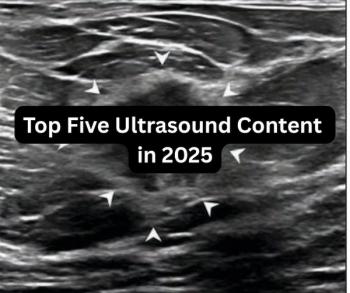
Integrating AI Into Radiology Practice to Enhance Lung Disease Prediction and Diagnosis
Artificial intelligence has been shown to be beneficial in the discovery of prognostic biomarkers for lung cancer diagnosis, treatment, and response evaluation.
Lung cancer continues to be the leading cause of cancer-related deaths globally, with
Artificial intelligence has been shown to be beneficial in the discovery of prognostic biomarkers for lung cancer diagnosis, treatment, and response evaluation, putting it at the forefront of the next phase of personalized medicine. Imaging is critical to all aspects of lung cancer care and has the potential to be a critical component of AI applications.
AI Tool Predicts Lung Cancer Combining Lung Screening CT and Clinical Data
According to
With the forthcoming extension of lung screening criteria to cover individuals who are deemed lesser risk only on the basis of their age and history of tobacco use, risk estimates among lung screening participants will become even more critical. According to Gao and co-authors, insights from this tool may reveal that otherwise low-risk people are really high-risk. In order to construct their deep learning method, the researchers used data from the National Lung Screening Trial (which included 23,505 patients) and a five-fold cross-validation technique. Approximately 150 patients who took part in an internal program were screened, and the results were utilized to do external testing.
In this study, deep learning outperformed previously published models based only on imaging data (0.86) and clinical risk variables (0.69), scoring 0.88 on the area under the receiver operating characteristic curve. One of the most significant advantages of this method is that it automatically extracts high-risk areas from CT scans without the need for radiologist intervention. At the same time, Gao et al. emphasized that obtaining clinical data still requires manual labor on the part of radiographers and other specialists. Gao et al. concluded that the radiologist's role in searching for and reporting clinically relevant pulmonary abnormalities - pulmonary fibrosis, rounded atelectasis, emphysema, among many others - remains essential.
A Boston-based Institution Found AI Tools Can Predict Emphysema Severity as Accurately as Professional Radiologists
Millions of people suffer from chronic respiratory ailments that affect their quality of life. Every year, more than
Characteristics of the life-threatening illness Chronic Obstructive Pulmonary Disease (COPD) include partially damaged alveoli and lungs that are overinflated - emphysema. In clinical practice, diagnosis, and assessment of emphysema are based on the patient's history, lung function, and abnormal chest radiographs, among other variables. In most cases, chest radiographic findings cannot be used to make a diagnosis of mild emphysema, however, when emphysema has progressed to a more advanced stage, standard radiographic abnormalities are usually detected. Routine chest radiographs may show indications of emphysema, but this is not a sensitive diagnostic method. Chest radiography, on the other hand, is effective in detecting problems during acute exacerbations and in ruling out other illnesses such as superimposed infection or lung cancer.
When it comes to forecasting the severity of emphysema in patients, artificial intelligence can match - sometimes even surpass - the accuracy of trained radiologists.
According to
The researchers at the Massachusetts General Hospital sought to automate lung evaluation in order to remove differences and improve the reliability of chest CT in identifying the severity of COPD. Researchers analyzed 113 patients who had a non-contract CT scan and a lung function test during a two-month period. The severity of the disease was graded as mild, moderate, or severe according to the amount of air that patients could exhale during a forced breath. Each individual's emphysema was graded on a five-point scale by two thoracic radiologists.
Mannudeep Kalra, M.D., of Mass General's Department of Radiology, and colleagues published on Oct. 14 that the performance of the tested AI prototypes was equivalent to radiologists' subjective interpretation of emphysema severity. Although the outputs from the tested AI prototypes were similar across various scanner types, scan parameters, and reconstruction settings, the scientists noted that owing to insufficient radiation exposure, there is a lack of consistent performance among individuals with greater body habitus.
Between 2018 and 2020, patients diagnosed with COPD had chest CT at a single healthcare facility. The research included CT scanners from three different manufacturers, with pictures analyzed using Siemens Healthineers' AI-Rad Companion Chest prototype. Philips evaluated bronchial abnormalities using trained radiologists and a completely automated program.
Using forced expiratory volume (FEV), AI and thoracic radiologists were successful in differentiating mild, moderate, and chronic emphysema, as measured by area under the curve ratings of 0.77 and 0.76, respectively. They observed a considerable positive correlation between them. Additionally, the combination of radiologist-assessed emphysema and bronchial abnormality quantification and AI evaluations may distinguish between various severity levels.
Jonathan Sharp is the CFO of
Newsletter
Stay at the forefront of radiology with the Diagnostic Imaging newsletter, delivering the latest news, clinical insights, and imaging advancements for today’s radiologists.




























